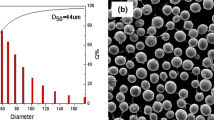Abstract
The powerful alternate magnetic field treatment is an effective not-heat treatment, which improves the coriaceous performance of the material. In order to reveal the effect rule of the powerful alternate magnetic field on the structure capability after thermal plastic forming, the experimental methods were adopted to compare the microcosmic structure of the LY12 aluminium alloy test pieces before and after the powerful alternate magnetic field treatment. The mechanism of the structure refining was analyzed theoretically. According to the effect rule of the alternate magnetic field on critical grain growth work and the magnetic vibration-constriction mechanism, the structure dynamics factors were analyzed. The results show that, after a certain powerful alternate magnetic field treatment, the mechanical capability of the LY12 aluminium alloy after thermal plastic forming can be reinforced, the structure intertwist deriving from the thermal plastic forming becomes even and the branch crystal is also smashed, consequently refines the structure. The powerful alternate magnetic field treatment can be regarded as an effective method to improve metal structure performance after heat plastic forming.
Similar content being viewed by others
References
REN Fu-dong. The study of the constant temperature quencher in 9SiCr steel magnetic field[J]. Journal of Metal Heating Treating, 1993, 15(5): 23–25. (in Chinese)
TANG F, LU A L, FANG H Z. Effect of magnetic treatment on magnetostrictive behavior of HT70 steel[J]. Mater Sci Eng, 1998, A248: 98–103.
KOCH C C. Experimental evidence for magnetic or eletric field effects on phase transformations[J]. Mater Sci Eng, 2000, A287: 213–218.
WANG **-ning, LIU Zheng. The study advance of the effect of the magnetic to the material solid metallography conversion[J]. Journal of Material Guidance, 2002, 16(2): 25–27. (in Chinese)
FANG **, HE Yan. Design and statistics[M]. Hangzhou: Zhejiang University Press, 2003. (in Chinese)
ZI Bing-tao, WANG Hui. The numerical simulation of pulse flux density and Lorentz force[J]. Journal of Rare Material and Engineer, 2003, 32(9): 689–692. (in Chinese)
ZI Bing-tao, CUI Jian-zhong. The comparison of LY12 aluminium alloy concretionary structure affected by pulse current and pulse magnetic field[J]. Journal of Heat Manufacture Technology, 2000(4): 3–5. (in Chinese)
CAI Z P, LIN A J, ZHOU A L. Evaluation of effect of magnetostriction on residual stress relief by pulsed magnetic treatment[J]. Materials Science and Technology, 2004, 20(12): 1563–1566.
LIN Jian, ZHAO Hai-yan. The improvement of the mechanical property of the iron magnetic material after magnetic treatment[J]. Journal of Mechanical Engineering Material, 2005, 29(5): 5–8. (in Chinese)
JILES D C, MINA M, JOHNSON M J, KOEPKE B, KERDUS L C, LEIB J. Evaluation of the effects of pulsed magnetic field treatment as a nondestructive treatment for magnetic materials[J]. Materials Evaluation, 2002, 60(8): 971–975.
WU Su, ZHAO Hai-yan, LU An-li, FANG Hui-zhen, TANG Fei. Micro-mechanism model of residual stress relaxation in steels by magnetic treatment[J]. Journal of Tsinghua University: Science and Technology, 2005, 42(2): 147–150. (in Chinese)
BATAINEH O, KLAMECKI B, KOEPKE B G. Effect of pulse magnetic treatment on drill wear[J]. Journal Materials Processing Technology, 2003, 134(2): 190–196.
WANG Zhong-qing, JIANG Shou-ting. The principle study of magnetic treatment technology[J]. Journal of Heibei Normal University (Natural Science), 1998, 22(1): 49–50. (in Chinese)
HIDEYUKI O. The effect of magnetic field to the metallography conversion grain growth[J]. Journal of Metal Material Study, 1999, 25(2): 63–67. (in Chinese)
GU **ao-an, XU Qing-xin. The mathematic model of the magnetic force got by magnetic material in magnetic field[J]. Journal of Controlling the Noise and Vibration, 2002(8): 10–11. (in Chinese)
MOLOTSKII M I. Theoretical basis for electro and magneto plasticity[J]. Materials Science and Engineering A, 2000, 289: 248–258.
Author information
Authors and Affiliations
Corresponding author
Additional information
Foundation item: Project(50675190) supported by the National Natural Science Foundation of China
Rights and permissions
About this article
Cite this article
Chen, Gx., Fu, Ym., Yin, J. et al. Effect of alternate magnetic field on LY12 structure properties after thermal plastic forming. J. Cent. South Univ. Technol. 15 (Suppl 2), 284–287 (2008). https://doi.org/10.1007/s11771-008-0472-2
Received:
Accepted:
Published:
Issue Date:
DOI: https://doi.org/10.1007/s11771-008-0472-2




